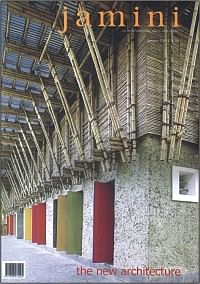'New styles of Architecture, a change of heart'

The present title alludes to W.H. Auden's poem ˜Petition' in which the poet-turned-Oxford-professor urges to 'publish each healer that in city lives'. The recent issue of Jamini on 'the new architecture' has a similar conviction. In a brisk survey of the recent architecture in Bangladesh, Kazee Khaleed Ashraf--Jamini's guest editor for this issue--and his co-writer Marina Tabassum forward a petition for an 'urgent architectural intervention' to stem the rot in our urban landscape. The lack of vision on the part of the city-fathers as well as the profit motive of owners and developers is duly blamed for the 'catastrophic nature of the urban environment'. In addition, Ashraf and Tabassum frankly admit that the 'large scale building enterprises triggered by a globalized economy and vying for an international standard' has become 'the order of the day'. The new generation of architects mentioned in the article offers a pleasant respite from the 'real- estate equation'. The construction of 'the gardens in the air' by the green architect Rafiq Azam, the poetic adoption of space after char-bagh by the Urbana architects Kashef Mahboob Chowdhury and Marina Tabbassum, the creation of 'Bengali moodiness' by Uttam Kumar Shaha are mentioned among others who manifest the new styles of architecture, heralding a change of heart.
While leafing through the glossy off-set pages of the impressive coffee-book that boasts of being an international art-quarterly, I was struck by the energy and vibrancy of the designs that celebrate the triumph of materiality, both at home and in abroad. Architects cannot simply take up adversarial stances against the machine culture and locate themselves outside the concrete jungle of materialistic life like some of their creative cousins in art and literature. The challenge for an architect is to give material expression to vision, or rather to realize their visionary forms. The designers create work of art neither to be enshrined in museums nor to be compartmentalized as a cerebral exercise. The beauty and the beauty-making power of the new architecture are not merely incidental or supplementary to the functionality of buildings; their function is to define our being and our sense of belonging. They use materials as an essential contribution to the quality of life and deserve our utmost attention. Hence, one undercurrent that runs through Jamini involves a certain 'rootedness' as well as a commerce between tradition and modernity. Indeed, the new architecture proclaims a unity of art, science and industry for the sake of an integrated organic existence.
The architects considered here are a varied lot. There is a splendid and welcome essay on the location of architecture by the guest editor who teaches at University of Hawaii. Ashraf finds human habitation analogous to that of an amoeba in which the form and formation is inseparable from its very location. The essay maintains a philosophical tone while dealing with issues such as the sense of locality and its naturalness and originality, the appropriation of land and language, and the portability and commodification of culture. Ashraf identifies these issues as pertinent to architecture across national boundaries almost as a justification for including current trends from Sri Lanka, India, California, Japan, Australia, Turkey and Switzerland. The 'glocal' (i.e. global + local) assortment chimes with the international claim of Jamini.
However, one feels that although the issue showcases expat Bangladeshi architects, it has not taken into cognizance the pioneers in this profession. Of the twelve pieces, only two articles deal directly with Bangladesh: the one on the recent architecture and the other on the dwelling of a Grameen Bank woman, whose new-found economic freedom finds expression in the house she lives. Of course, there are things to be learnt from abroad and it is indeed a matter of national pride that our architects are designing buildings of international stature in different parts of the world (an impression that we get from the credit lines of some of the photographs). While a display of international standard glasshouses and trendy green houses represent Dhaka, a smart selection of photographs of the Bengal Bangshai Bari at Savar, SOS complex at Bogra, Bangabandhu Mausoleum at Tungipara, Govinda Gunalanker Hostel in Chittagong makes us aware of the presence of interesting constructions and designs outside Dhaka.
Somehow, I was expecting the presence or at least the mention of the traditional architectures that created the foundation for the 'new architecture'. To be precise, a piece on the role of the Architecture Faculty of BUET and its contribution to the new architecture seems to be a notable exclusion. It is important to learn about the Sri Lankan architect Geoffrey Bawa or Peter Zumthor of Switzerland. As a local reader who does not belong to the 'glocal' architecture community, I would have loved to know more about the legacy of Majharul Islam, F. R. Khan and the like. I am sure the modifier 'new' in the title can be used as a counter argument to brush me aside as conservative.
Nonetheless, the regular editorial board of Jamini deserves credit for bringing life back to Jamini after an uncanny silence, and for choosing architecture as a topic of an art magazine. The topic widens the scope of art and focuses on its interdisciplinary aspects. As ever, Jamini yields high-performance and maintains a very high standard -- it gives value for money. Finally, I would like to thank the Jamini team for the cover illustration, featuring the colorful primary school at Dinajpur designed by the Austrian architect Anna Heringer. The delightful use of materials like bamboo, mud and saris has not only brightened up the innocent faces of primary students but also the cover of Jamini. The simplicity of form, lines and color reaffirms the idea that it does not take much to live both fully and beautifully.
Shamsad Mortuza is chairperson, English department, Jahangirnagar University.

 For all latest news, follow The Daily Star's Google News channel.
For all latest news, follow The Daily Star's Google News channel. 



Comments